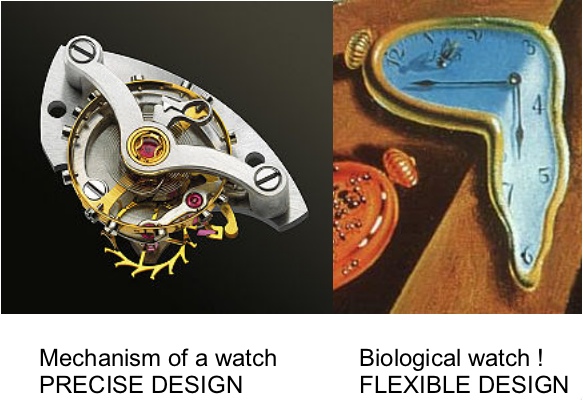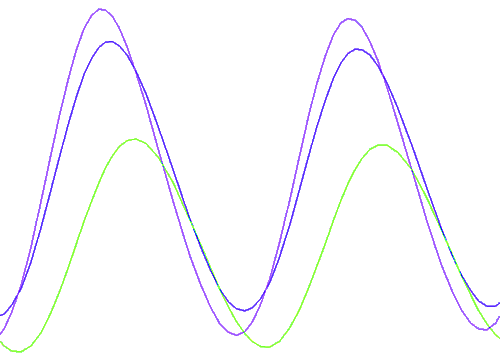Team:Paris/Project
From 2008.igem.org
David.bikard (Talk | contribs) |
|||
| (70 intermediate revisions not shown) | |||
| Line 1: | Line 1: | ||
{{Paris/Menu}} | {{Paris/Menu}} | ||
| + | {{Paris/Header|Presentation of the project}} | ||
| + | {{Paris/Section_contents_project}} | ||
| + | = Outlines = | ||
| + | [[Image:Specmontre.jpg|right|250 px]] | ||
| - | + | Our BacteriO'Clock project aims at constructing a '''First In First Out (FIFO) periodical system synchronized at population scale'''. To this end we implement a biological FIFO circuit in a negative feedback loop and a cell-cell communication channel. Such a setup is designed to trigger a sequence of several genes successive activations repeated periodically. Thus, it can be considered as a biological clock. | |
| - | Our project aims at | + | |
| - | * | + | * '''FIFO behavior''' : Our setup involves three genes which will get activated and deactivated successively following a “FIFO : First In, First Out” order. This sequence is monitored by a logic structure called Feed-Forward Loop (FFL).We base this part of our project on an already existing structure, partly fulfilling the evoked specifications: the system that leads to the production of ''E. coli'' flagella. What is most interesting in a FIFO is the study of the ON and OFF steps. An easier way to observe the FIFO would be to have automatic oscillations. |
| - | + | ||
| - | + | ||
| - | + | * '''Oscillatory behavior''' : It will consist in providing a periodic output for the duration of the experiment. To do so, we will use a genetic cascade, initiated by a specific inducer which last step will inhibit the previously mentioned inducer. The period of the oscillations is even more interesting if it allows the sequential switching on and off of several genes. | |
| + | * '''Synchronization''' : Yet, being able to control this sequential activation within a single cell can be seen as a “first step” in biological clock devising. In order to amplify this phenomenon (to observe it in an easier way or even to find future applications), it has to be extended to a whole population of bacteria. Here comes the synchronization issue: we will use methods based on the “quorum sensing” phenomenon. | ||
= Motivations = | = Motivations = | ||
| Line 15: | Line 17: | ||
== FIFO == | == FIFO == | ||
| - | + | [[Image:Queue2.jpg|left|thumb|300px|A queue in front of the Post Office traditionally works as a FIFO : the person arrived first will be the first served, and will ''probably'' leave the Post Office first.]] | |
| - | |||
| - | + | First In First Out (FIFO) systems are present everywhere from flux management or electronics to genetic networks. A queue in front of the post office works as a FIFO. More generally, it is interesting in any process that requires several steps in a defined order. FIFO behavior indeed prevents from needlessly performing the first steps while the last ones are OFF. | |
| - | + | <span style="font-size:10; color:grey;">''If you want to make French fries you need to produce potatoes before you can cut them and you need to cut them before frying them. But it would be a waste to continue producing potatoes if you've already turned off the fryer. You would accumulate unprocessed intermediates !''</span> | |
| - | + | ||
| - | |||
| - | |||
| - | + | The same goes for the bacterium flagella. To be efficient they naturally need to produce the proteins of the base first. But when you stop making flagella, the base proteins are also the first thing you need to stop producing. It has been proposed [http://www.ncbi.nlm.nih.gov/pubmed/15186773?ordinalpos=2&itool=EntrezSystem2.PEntrez.Pubmed.Pubmed_ResultsPanel.Pubmed_DefaultReportPanel.Pubmed_RVDocSum| (Kalir S., Alon U. 2004)] that the gene network controlling the production of E.coli flagellum behaves as a FIFO. We thus decided to use this regulatory network to implement our FIFO. | |
| + | <br><br> | ||
| - | + | For more details, see here : | |
| + | *[[Team:Paris/Analysis/Design1|Explanations for the FIFO]] | ||
| + | |||
| + | == Oscillations == | ||
| + | [[Image:Oscill.png|right|thumb|250px]] | ||
| + | Genetic oscillators based on the interaction of a small set of molecular components have been shown to be involved in the regulation of the cell cycle, the circadian rhythms, or the response of several signaling pathways. Uncovering the functional properties of such oscillators then becomes important for the understanding of these cellular processes and for the characterization of fundamental properties of more complex clocks. | ||
| - | + | Creating an oscillating device has always been at the core of synthetic biology. There are many systems that can lead in theory to this complex behavior with different properties : number of cycles, oscillating period and robustness. Our oscillator has an original structure that has not been tested yet, based on a particular gene network called Feed Forward Loop. | |
| + | Engineering and tuning such complex cellular behaviors is a real challenge for synthetic biology. | ||
| + | For more details, see here : | ||
| + | *[[Team:Paris/Analysis/Design2|Details about the oscillations]] | ||
| + | == Synchronization == | ||
| + | [[Image:synchro.jpg|left|thumb|250px]] | ||
| - | + | In order to make visualization easier and to permit the development of future applications, our system must reach a higher scale. As a consequence, the synchronization of the oscillation at a population level is a key issue in our system. The classical way to do so, is to introduce a ''checkpoint'' at the end of each cycle, as in the eukariotic cell cycle. | |
| + | |||
| + | Several teams around the world worked on the synchronization of oscillations. The phenomenon of ''quorum-sensing'', is a natural way to synchronize the expression of gene network in bacteria. We will embezzle a natural ''quorum sensing'' system to do so. | ||
| - | + | For more details, see here : | |
| + | *[[Team:Paris/Analysis/Design3|Details about the synchronization]] | ||
| - | + | {{Paris/Navig|Team:Paris/Project}} | |
| - | + | ||
| - | + | ||
Latest revision as of 07:00, 30 October 2008
|
Presentation of the project
OutlinesOur BacteriO'Clock project aims at constructing a First In First Out (FIFO) periodical system synchronized at population scale. To this end we implement a biological FIFO circuit in a negative feedback loop and a cell-cell communication channel. Such a setup is designed to trigger a sequence of several genes successive activations repeated periodically. Thus, it can be considered as a biological clock.
MotivationsFIFO
If you want to make French fries you need to produce potatoes before you can cut them and you need to cut them before frying them. But it would be a waste to continue producing potatoes if you've already turned off the fryer. You would accumulate unprocessed intermediates !
The same goes for the bacterium flagella. To be efficient they naturally need to produce the proteins of the base first. But when you stop making flagella, the base proteins are also the first thing you need to stop producing. It has been proposed [http://www.ncbi.nlm.nih.gov/pubmed/15186773?ordinalpos=2&itool=EntrezSystem2.PEntrez.Pubmed.Pubmed_ResultsPanel.Pubmed_DefaultReportPanel.Pubmed_RVDocSum| (Kalir S., Alon U. 2004)] that the gene network controlling the production of E.coli flagellum behaves as a FIFO. We thus decided to use this regulatory network to implement our FIFO.
For more details, see here : OscillationsGenetic oscillators based on the interaction of a small set of molecular components have been shown to be involved in the regulation of the cell cycle, the circadian rhythms, or the response of several signaling pathways. Uncovering the functional properties of such oscillators then becomes important for the understanding of these cellular processes and for the characterization of fundamental properties of more complex clocks. Creating an oscillating device has always been at the core of synthetic biology. There are many systems that can lead in theory to this complex behavior with different properties : number of cycles, oscillating period and robustness. Our oscillator has an original structure that has not been tested yet, based on a particular gene network called Feed Forward Loop. Engineering and tuning such complex cellular behaviors is a real challenge for synthetic biology. For more details, see here : SynchronizationIn order to make visualization easier and to permit the development of future applications, our system must reach a higher scale. As a consequence, the synchronization of the oscillation at a population level is a key issue in our system. The classical way to do so, is to introduce a checkpoint at the end of each cycle, as in the eukariotic cell cycle. Several teams around the world worked on the synchronization of oscillations. The phenomenon of quorum-sensing, is a natural way to synchronize the expression of gene network in bacteria. We will embezzle a natural quorum sensing system to do so. For more details, see here :
|
 "
"






